
30 minute read
Victory is Ours The new
BY RITA CALVERT VictorY VictorY is OuRs is OuRs
The new Victory Garden movement for our times has taken root
While COVID19 raged, there was a new breath of life into the Victory Garden movement, also known as Grow It Yourself. “Food Supply Anxiety Brings Back Victory Gardens,” proclaimed the New York Times in late-March 2020. The term was used during World War II to describe small vegetable and fruit gardens at homes, parks, and other public spaces, promoting gardening for unity. But the idea actually started in World War I, when such spots were called Liberty Gardens to help secure the national food supply. Youth gardeners were recast as “soldiers of the soil,” and no plot was left uncultivated, lest it be considered “slacker” land. Rose Hayden-Smith writes in her 2014 book, Sowing the Seeds of Victory: American Gardening Programs of World War I, “Gardens were ‘munitions plants,’ garden furrows became ‘trenches,’ and food was referred to as ‘ammunition.’ Victory Gardens drove the creation of 20 million gardens. These gardens lessened food chain demands and boosted morale.”
The 2020–21 pandemic has given us a new awareness of the origin of our food, an awareness that was not always pleasant. Due to immense breakdowns in food distribution, supermarket shelves were left bare while newscasts about milk being dumped and produce rotting in the field or being plowed under, abounded. The industrial food system was showing cracks. At the same time, food pantry lines stretched for miles; many in the wait being folks who had never needed food aid in the past. This occurrence was about supply and demand as well as food security. But, when the going got tough, Americans also turned to more gardening—for sustenance and comfort.
Now, the initiative to “grow your own food” is about establishing food resilience while being out in nature in our COVID-complicated world. Timing was perfect in the sense that March was the beginning of growing season locally or at least the time to shop for garden supplies, whether for a nice-sized plot in the yard, a container garden, or a simple pot or two in a window.
Garden centers and longtime gardeners have noticed more novices this year picking their brains on tips and troubleshooting. Many fledgling gardeners were educated by a healthy dose of internet research.
Take Annapolitan Christina Berry, who had no background in growing food and turned it into a family-friendly hobby. Now she says, “It’s been super fun, especially having my five-year-old out there with me, taking earthworms to the compost and learning about plants together as he’s been digging and planting with me.”
There was, however, an unexpected downside to the explosive growth of gardening. Nursery products, seed companies, canning supplies, and even chicken wire were in unexpected demand. For example, Johnny’s Selected Seeds in Fairfield, Maine, saw a 270 percent jump in orders the week of March 16, 2020, after U.S. President Donald Trump, Jr., declared a national emergency over the coronavirus. Suddenly, vegetable seeds, soil, and canning supplies were sold out from new interest. Annapolis’ Bowen’s Farm Supply says their canning jar stock has been sold out since April 2020, but they’re hopeful that their suppliers are ramping up to help them meet demand.
“No worries at this point in time,” advises garden center consultant and garden grower, Jen Hurt. “Garden centers seem to be wellstocked again. Some of their initial orders were reduced as retailers were initially closed before being categorized as an essential business. Then they needed to up their orders (difficult because initial orders are placed six months in advance before anyone anticipated the virus and its impact on gardening interest). Some items were very scarce: e.g. seeds, because sales were so high; plant starts, because initial orders actually were cut down when the virus led to retail shut downs. When summer came, though, stock for most things improved for the unanticipated boom. Online seed sales generally caught up to demand.”
Hurt also adds, “I noticed that several [garden centers] started advertising earlier for 2021 than usual, most likely in anticipation of heavy orders. Catalogs have been arriving in the mail and inboxes are full of selections and recommendations.”
Local Inspiration Sources
Nonprofit Annapolis Green, with a keen eye on local environmental trends, introduced a new program: Here We Grow. Founders Elvia Thompson and Lynne Foresman state, “There are two actions resonating with many people during the COVID crisis: gardening and cooking. This program introduces a modern-day Victory Garden project to encourage people to value the land and nature by installing, developing, or updating their gardens to provide beauty, food, and pollinator habitat. It will educate, provide resources, and inspire, both online and in-person, and create a ‘club’.”
Here We Grow’s program and participants came to several conclusions. The industrial food distribution system is easily disrupted and could likely get worse with climate change. People need to connect to nature and understand where their food comes from in order to take action to protect the environment. There is growing interest in gardening and cooking during this time—a trend that is likely to continue.
“Over the last few years, our [former] home and garden at The Green House on Maryland Avenue was a beautiful example of urban gardening, fueled by our ‘secret ingredient,’ the compost we sell that’s comprised of waste from many of our responsible events and festivals,” Forsman explains. “It made sense to have our garden serve as the centerpiece and demonstration garden. Our compost and organic potting mix are available for sale,” which supports Annapolis Green’s mission.
Beth Stang, gardener and landscaper at The Inn at Chesapeake Bay Beach Club on Kent Island, says, “These times are absolutely the perfect time for a Victory Garden. I feel like I have always had the ability, but with COVID, everyone wanted to get out there and grow. Even I had a tough time finding seeds and plants in the spring of 2020. I hope everyone will continue their gardens. We are starting brassicas, Brussels sprouts, broccoli, cauliflower, and lettuce.” Stang expresses enthusiasm for the Facebook group, Dirty Annapolis (information follows), and says she also could help answer questions on invasives— bugs, blights, or disease.
The Gardens of Queen Anne, as the Inn’s gardens are named, are done with quite a creative flare as Stang has had the chance to experiment with building much of the garden supports: cattle fencing acts as a trellis for climbing vegetables; charming strawberry
planter obelisks were built by JP Anthony, director of facilities; there are A-frame hot houses with Plexiglas doors, which can be removed in hot weather; and tall wooden Tuteurs (three dimensional trellis) support vines of hops for beer making. “It’s the place I go for inspiration and garden chitchat,” she says.
Greg King, manager and buyer of hardgoods, annuals, and perennials at Potomac Garden Center says, “We had a great year in sales all over the garden center in 2020! Herbs and vegetables, both seeds and plants, were overwhelmed by customer demand. Perennial sales were outstanding. Raised bed sales were off the charts, along with all products relating to them.
“People had a lot of unexpected time on their hands and a desire to take control of their food source. They wanted to take that unspent energy in a positive direction and grow their own food. They wanted to create a safe haven, where they could relax with plants and be in nature. They were telling us they want organic and raised bed vegetable gardens.”
LOCAL SOCIAL (MEDIA) SOURCES Dirty Annapolis
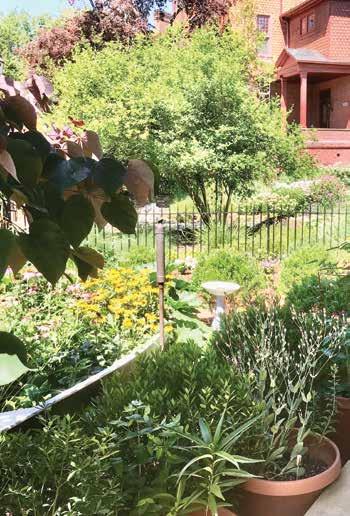
This social media group was founded on Facebook Groups in April 2020 by Tim Hamilton, Marketing Manager for State Parks with the Maryland Department of Natural Resources, also a former marketing director for Homestead Gardens, and avid home gardener. Gardening newbies and old hands share tips, produce progress, and answer perplexing
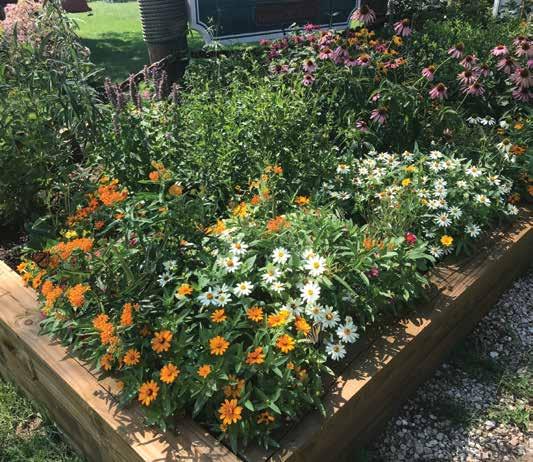
The Gardens of Queen Anne, as the Inn’s gardens are named, feature a range of garden supports, including cattle fencing, strawberry planter obelisks, A-frame hot houses with Plexiglas doors, and tall wooden Tuteurs (three dimensional trellis) to support vines of hops for beer making.

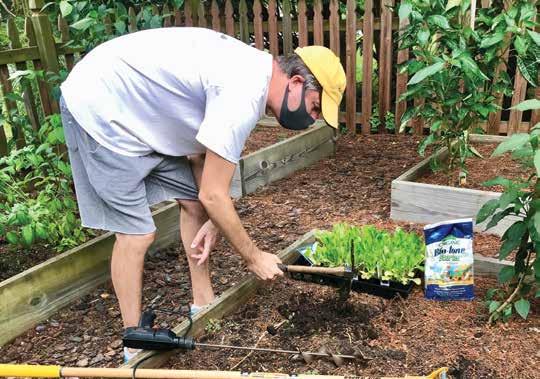
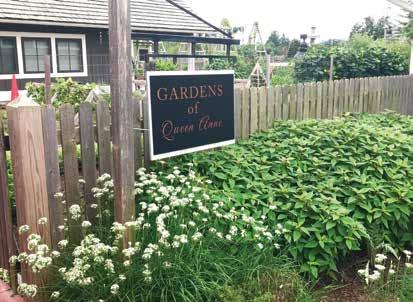
questions. The group is for novice, casual, serious, and expert gardeners alike in and around Annapolis. Ask or answer questions about anything garden-related that is specific to our area.
Why the heading, Dirty Annapolis? Hamilton says it came about because he loves to get dirty in the garden and his wife would comment on his disheveled condition. He thinks it’s just great, to be like a kid out playing and thus the title. To further confirm Hamilton’s wit, he has done stints in standup comedy. So, when COVID19 raged into our lives, he says he had the excuse to stay in the garden all the time!
With close to 800 members, Dirty Annapolis serves as a Q&A resource on gardening and identifying plants, weeds, diseases, and bugs. There is also a close-knit sharing component. “Humans love community and Dirty Annapolis helps fill that need,” Hamilton says.
Homestead Gardens
Horticultural center, Homestead Gardens, is known regionwide for its vast selection of plants, flowers, trees, tools, landscaping services, housewares, decorations, and all manner of garden supplies. But the Davidsonville-based company has developed a strong digital presence on Facebook and offers weekly virtual chats, such as the popular “Grow Live!” program hosted every Monday at noon, and “Houseplant Haven,” described as “a community for those who are just finding their green thumb as well as master gardeners looking for a new challenge.” Homestead also has a vast how-to video library on their website, as well as plant look-up tools, tips, and trends. Just click on “Learning Center” at the website homesteadgardens.com.
Capital Naturalist
Founded by Alonso Abugattas, naturalist, storyteller, and environmental educator, this social (media) butterfly shares his insights, while asking others to share theirs, about the nation’s capital’s natural world on Facebook, YouTube, Twitter, and Blogspot.
On a final note, Green America—a national nonprofit founded in 1982 with the mission of harnessing economic power (the strength of consumers, investors, businesses, and the marketplace) to create a socially just and environmentally sustainable society—reminds us, “Planting a garden has the power to change the world.




An Asian American Tale How the arrival of eastern cultures, their struggles, and assimilation into the American story have inspired generations of success and achievement // By Soo Youn
Editor’s note: Our publication continues this series of articles that will explore, address, and attempt to convey with empathy and direct perspective issues of race and culture within our communities. These issues are not limited to racial inequalities or suffering. We intend to also share stories of success and hope. The second article in this series is written by journalist Soo Youn, an experienced professional who has written for The Guardian, CNN, CNN Business, ABC News, The Washington Post, The Wall Street Journal, Harvard Health Publishing, ABC NewsOne, Aol, and Yahoo News UK to name a few publishers. Youn conveys her personal story, and those of several other families, of having grown up in the Chesapeake Bay region within the context of the greater Asian American experience of immigration and assimilation. “I could see, across the river, the track field and buildings of the famous U.S. Naval Academy, and further down the river, the Bay Bridge is also visible. It was a clear sunshine [sic] day in the early spring, the breeze, not salty, but cool and fresh, made me feel once again the call of the mighty and stormy sea as well as the charm of a little seaside town, which I had missed so much and so long while in State College.”
In mid-April 1977, Yen-Yi Wu first laid eyes on Annapolis while visiting for a job interview. The software engineer with a Ph.D in mathematics from Penn State University already had several job offers, but the commanding views of the white-walled academy accompanied only one. Wu grew up in Keelung, a major port city on the northeastern edge of Taiwan near Tapei with its own harbor, and the Annapolis vistas evoked a longing for home, as he noted in an essay he wrote for his family in 2005.
Families Bond
Wu left Taiwan in 1964, arriving first at Berkeley, then to Pennsylvania for his doctorate. Then, like few Asians before him, he moved to the Annapolis area to work for IITRI, a company contracted to the Department of Defense to maintain its radio frequency resources for U.S. military units around the globe. In the summer of 1977, he moved his family—his wife Sabrina and his children, Craig and Chrissy, into a house in Arnold, just seven miles from where he would work until he retired in 2001. When young Craig started at Belvedere Elementary School that year, there were two classmates who were ethnically Chinese. A few days later, a woman identifying herself as Mrs. Hon called. She was the mother of one of Craig’s Chinese classmates at Belvedere.
“We were both surprised and delighted to finally meet a family from Taiwan that had a similar background as ours,” Wu wrote. Mrs. Hon introduced them to the Chis—whose daughter was also in Craig’s class. The Hons had been in Arnold for a while, but the Chis were also recent transplants who had moved so Professor Chi could teach computer science at the Naval Academy. A fourth family, the Leungs (who moved when their father took a job teaching math, also at the Academy) rounded out the group.
“All of a sudden, we had four families, each with school children of similar ages, living in the same area, and it was no surprise that [the] four families became very close since then,” Wu said.
And that’s exactly four more Taiwanese—or any Asian—families I [the author] would have expected to find in the area then. Soon enough, my own family would connect with the others.
On October 3, 1965 President Lyndon B. Johnson signs the Immigration Act as Vice President Hubert Humphrey, Lady Bird Johnson, Muriel Humphrey, Sen. Edward (Ted) Kennedy, Sen. Robert F. Kennedy, and others look on at Liberty Island, New York. I had gone through most of elementary school in the 1980s without encountering another Asian student. Then, in middle school, I met Chrissy through All-County orchestra. Later, we both attended Severna Park High School. My memory is inexact, but I believe there were also a couple other students who were south Asian refugees, having arrived in fifth or sixth grade. Occasionally, people confused all of us, saying we looked alike. We did not.
The Immigration Wave Explained
That trickle of Asians to the area tracks the greater immigration trends for Maryland and the U.S. at large. In the midst of the Civil Rights Era, Lyndon Johnson signed the Hart–Celler Act, or the Immigration and Nationality Act of 1965 into law, abolishing the National Origins Formula or per-country immigration quotas, that finally allowed Asians to immigrate to the U.S.
From the 1920s, U.S. immigration policy had restricted immigration to people from northwestern Europe, serving to discriminate against Asians, and southern and Eastern Europeans (Jewish and Italian Americans fell into this category). The 1924 Immigration Act succeeded in barring immigration for Asians who were not previously excluded from immigration laws, notably the Japanese.
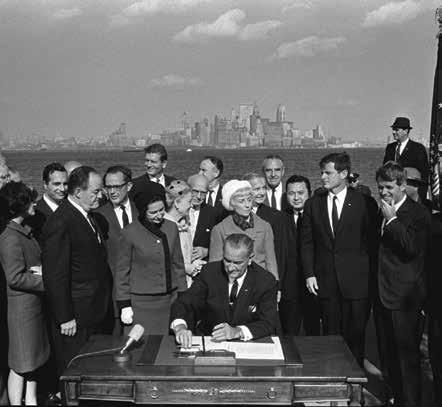
In his 1925 manifesto, Mein Kampf, Adolf Hitler expressed admiration of America’s immigration laws as an aspiring example for Germany, writing: “The American Union categorically refuses the immigration of physically unhealthy elements, and simply excludes the immigration of certain races.”
In fact, Asian Americans can trace their history to Maryland at least as far as 1870.
That was the first year the racial category “Chinese” was added to the census, according to Mike Friedrich, a public affairs specialist at the U.S. Census Bureau. “Two people in the whole state of Maryland!” he wrote in an email. In 1880, the government added “Japanese” as a category.
But after 1965, everything changed.
“It’s the law that ended Asian exclusion,” says Occidental College history professor Jane Hong.
“The way that it was originally written was it was supposed to be half skilled and then half family relationships that get you in. But at the last minute, some lawmakers who really wanted to restrict nonwhite immigration changed the formula,” Hong, author of Opening the Gates to Asia: A Transpacific History of How America Repealed Asian Exclusion, explains.
“There’s no numerical limit on family visas. They did that on purpose because they thought fewer nonwhite people would come, because mostly European people came historically. But the unintended consequences were that the people who ended up using the family visas were Asians and Latinos. That’s how the rest of my family came,” she says.
Before 1965 about 100 to 185 Asians came to the U.S. per country every year, Hong says. In the 1940s and ’50s, the vast majority of Asians came to the U.S. outside the quotas as students, military brides or refugees, or other special categories.
“But ’65 opens the gates for everyone. Before then, there were basically racial restrictions
by way of nationality restrictions,” Hong says. For the first time you had tens of thousands, then many more Asians emigrating.
Personal Journeys to America
In fact, Hong’s own family also moved to the Chesapeake Bay area in the late 1980s. They had initially immigrated to New York City, where Hong was born. But after her father died, her mother moved the family to Salisbury, where she worked at a nursing home. It was a huge adjustment from New York, where her parents had opened a deli in Brooklyn Heights, a much more familiar Korean American narrative. By then, there were enough Koreans locally that Hong’s family attended an already-established Korean church.
Her mother was a nurse, as was her now mother-in-law, who immigrated to Los Angeles, both on skilled worker visas. Her mother immigrated from Korea in 1975, the same year as my parents.
“That’s very common. It’s equally common among Filipino Americans. There’s a long history of U.S. colonialism: setting up an educational system, hospitals, industries in the Philippines and South Korea. So, there’s a whole historical legacy there,” Hong says. She argues that the push for Asian immigration to the U.S. came from protecting U.S. military troops and economic interests in Asia after World War II.
My [the author’s] father traces our American story to the Vietnam War, when the U.S. suffered a shortage of doctors, which dovetails into the Immigration Act of 1965.
The U.S. recruited Foreign Medical Graduates (FMGs) mostly from postcolonial Asian nations, like my father, who received permanent residency or citizenship for their medical service, often in marginalized communities. Originally conceived as a temporary solution, it has become a fixture in American immigration to this date.
This provision prompted waves of Asian doctors in the 1960s and 1970s to come to the States, particularly from Korea, China, and the Philippines, then later India and Pakistan. Like Hong’s mother, my family came in 1975 to Richmond, Virginia, where my uncle and aunt—an anesthesiologist and nurse, respectively—had moved in 1967. We then spent a year in rural North Carolina, where my father worked in a mental hospital with a friend from medical school in Korea who was like him, trained as a pediatrician—such was the need for foreign doctors. Afterwards, we ended up in Maryland. When I was six years old, we moved to Severna Park, where I grew up.
Adolescence & Race
There was racism, of course. I remember being beaten up—punched a few times as I walked home from school by a blonde-haired brother and sister who were older than me. I remember thinking their hair looked like Malibu Barbie. We were friendly in high school and never talked about it—the girl was sheepish around me.
When I reconnected with Chrissy, now Christine Wu Nordahl, she said she remembers growing up without a lot of racism because there were so few Asians to even generalize about, which I somewhat agree with. My high school guidance counselor always called me Kim, which was curious.
I reconnected with Sonya McFarland, who I knew as Sonya Lee, the other Asian girl I remembered from Severna Park. Her dad had been in the Korean military and befriended an American soldier who worked at General Motors—they fixed machinery or trucks together.
The American offered to help Sonya’s dad find a job should he come to the States. Sonya’s father took him up on it and ended up with a job at a GM plant in Maryland, without experience. He learned on the job and spent his breaks in the bathroom reading manuals and cramming.
I asked Sonya if she agreed with Chrissy’s take, that the scarcity of Asians translated into a lack of racism. She and Chrissy were often mistaken for each other, so much so much so that their nicknames for each other were Chrissy Lee and Sonya Wu.
We talked about how people were in general well-meaning, and earnest. Despite remembering very little of that time, she does recall being called “banana” and “Twinkie” and also “chink” by friends she had known since kindergarten.
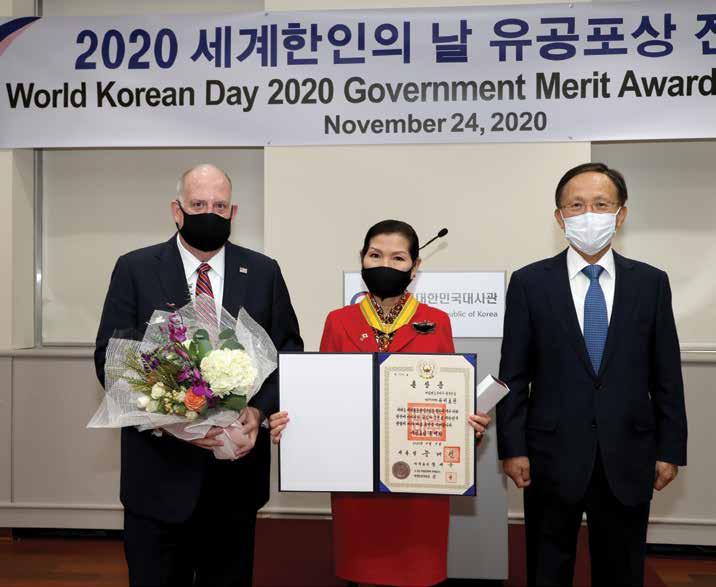
Maryland’s First Lady Yumi Hogan has long been a champion of Asian American awareness, recognition, and relationships. In November of last year, Hogan received the Order of Civil Merit of the Republic of Korea—the nation’s highest and most prestigious civilian honor. The Camellia (Dongbaek) Medal was awarded in recognition of the First Lady’s commitment to serving the Korean American community and strengthening ties between the United States and the Republic of Korea. Photo by Steve Kwak/Office of Governor Larry Hogan. The other thing she distinctly remembers is a fact-box in her older brother’s yearbook from 1990. It broke down Severna Park by race: 97 percent white, 2 percent Black, 1 percent other. “We were other,” she said.
Yet, as the Asian American population increased in the U.S. we assumed it would get easier. I remember always wanting to be younger, because it would be that number of years less racist, and less hard to not be white in America. For a while, for me, and others, it did seem like it was getting better.
Who We Are and Aren’t, Today
By 2018, the estimated number of U.S. residents identifying as some degree of Asian was 22.6 million, according to the UCLA Asian American Studies Center, which partners with the U.S. Census Information Center.
That breaks down into 5.2 million Chinese (excepting the Taiwanese), Asian Indian (4.5 million), Filipino (4.1 million), Vietnamese (2.2 million), Korean (1.9 million), and Japanese (1.5 million).
The current U.S. population is 331 million.
In 2019, Maryland’s population was 6.05 million—58.5 percent White, 31.1 percent Black, 10.6 percent Latino or Hispanic, and 6.7 percent Asian, according to the U.S. Census Bureau. Marylanders who identified as having two or more races numbered 2.9 percent.
Last year started off with a culturally groundbreaking moment for Asian Americans. For many, it signaled a sort of arrival. A Korean
film, Parasite, won four Academy Awards, and made history by becoming the first non-English film to win the Best Picture Oscar.
That seemed to build off of the momentum of Crazy Rich Asians, which enjoyed unexpected box office success, and two Golden Globe nominations in 2018. Lulu Wang’s The Farewell broke records in 2019 for theater average on opening weekend, topping even Avengers: Endgame. It seemed that Asian representation was pushing new frontiers and being not just embraced, but wildly celebrated.
Then COVID19 struck the U.S. full force. As the virus raged, so did anti-Asian sentiment, stoked by the then-President’s constant race-baiting moniker “China virus.”
As COVID19 initially made its way through America, I was living in Brooklyn, one stop from Manhattan’s Chinatown. On January 25th, to mark the Lunar New Year, I hosted a party. On the way, a friend noticed that an older Asian man had coughed on the subway, and other riders had glared and moved away. “It’s starting,” she said. We knew what was going to happen next.
As the weeks and months unfolded, so did reports of attacks on Asians and Asian-owned businesses both in the news media and in our own whisper networks across the U.S. My friends and I worried about our parents—and they, in turn, worried about us being in the city, because of both COVID and racism. One day I opened Facebook to find a friend from Severna Park (going back to first grade!) saying she was “proud of” her nephew writing “China virus” across his school calendar. I rarely comment on such things but this time I did, and she maintained it was not racist. While heartbreaking, I cannot say I was surprised.
Maryland’s own First Lady, Yumi Hogan, witnessed hateful actions as well.
“I am saddened that our community has faced that sentiment and went through unacceptable incidents. First generation Asian Americans are actually immune to it—think about how their life has been,” she wrote in an email, a stoic cadence I find so familiar from that generation of immigrants.
“They were obviously nervous, for example, when hearing ‘go back to China’ at a market. Some Asians regardless of their origin heard that. Young generations were also worried about it and tried to find a way to protect our community,” she said, referencing letters she received.
Hogan herself immigrated to the U.S. 42 years ago and has lived in the state for the past three decades. Like Wu, she had embraced Maryland for terrain evocative of home.
“Its landscapes—with mountains and the ocean and four seasons—much look like those of South Korea, my homeland,” she said.
I asked Hogan about the highly anticipated film Minari, about a Korean American family’s struggle to farm in Arkansas, written by the Korean American screenwriter Isaac Lee Chung, which features an ethnically Korean cast starring Steven Yeun. Heading into the Hollywood awards season, the film’s classification is “foreign film” by the Hollywood Foreign Press Association (HFPA) who administer the Golden Globes, and not a contender for either best picture awards, but rather considered a foreign language film.
“It is based on not a story in Korea, but a story of Korean American immigrants living in America. It is absolutely an American story, our story,” Hogan wrote. “Defining it as a foreign film is going backward. This is another type of discrimination.”
The celebration of art in 2020 did not reflect the anti-Asian sentiment so flagrantly on display in everyday life. The National Book Awards showcased Asians or Asian-Americans as three of the five winners: the novel Interior Chinatown by Charle Yu, the poetry collection DMZ Colony by Don Mee Choi, and the translated novel Tokyo Ueno Station by Yu Miri.
For Hogan, the most arguably high profile Asian American in Annapolis, or Maryland, there is much to celebrate in the arts, a course of action she advocates.
“I am proud of wonderful artists who make great artworks that represent and raise the voice of immigrants and remind all of us of what American history is about. Different cultures, foods, and languages are part of the diversity America is proud of and learning or knowing them is your strength,” she said. “Enjoy, support, and share them and talk about them more.”
Journalist and writer of this article Soo Youn grew up in the 1980s and ’90s in the Severna Park area, just outside Annapolis.
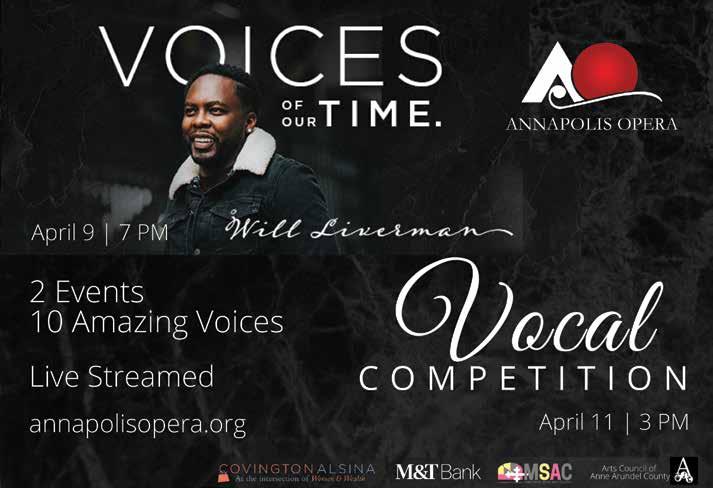
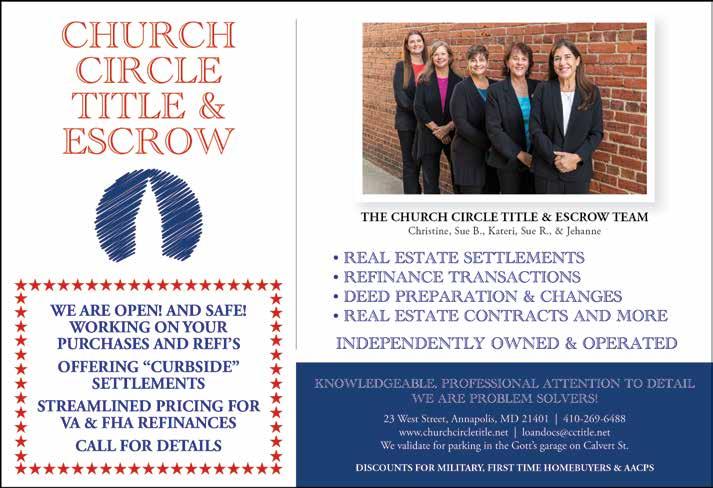


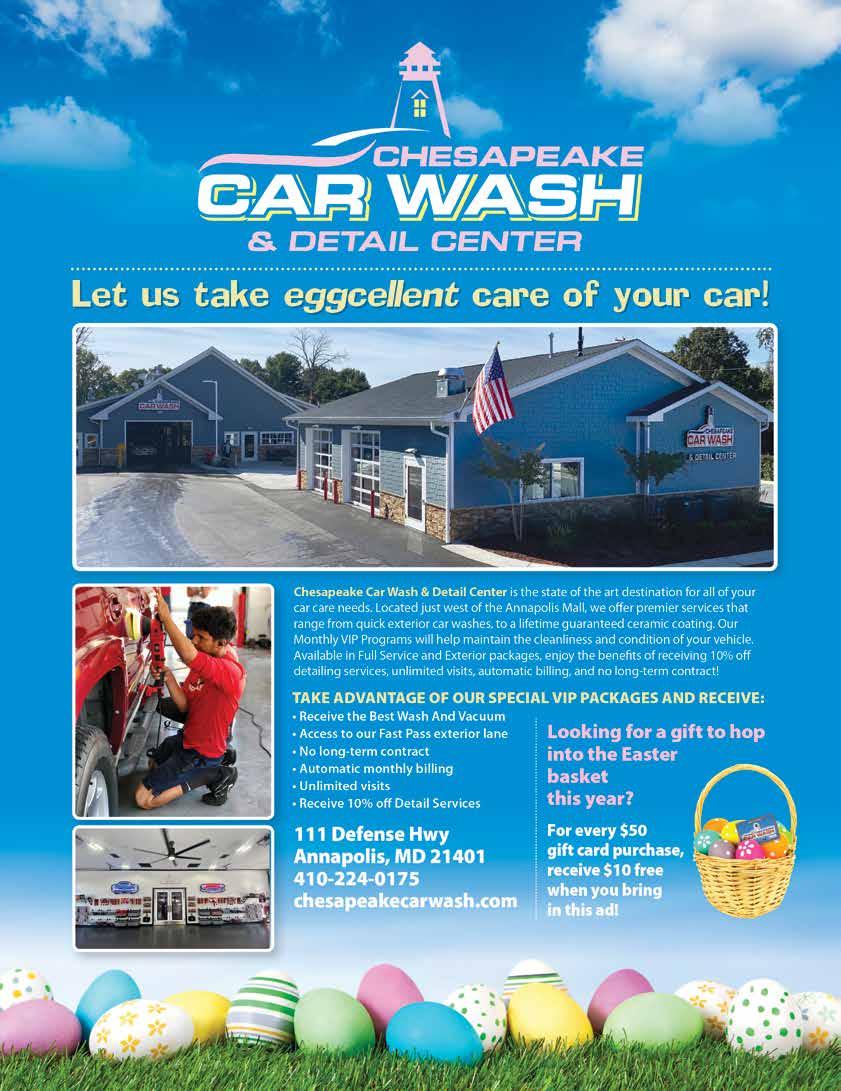
Save the Date!
PHILANTHROPIC CALENDAR
COMPILED BY MEGAN KOTELCHUCK
In-person events may be scarce, but that doesn’t mean fundraising won’t be fun this year! As hard as the last year plus has been for all of us, it has been just as difficult for those non-profits who do great things for our community year after year. Whether it be socially distanced or virtual, find the cause that sticks out to you and attend (or log on to) their philanthropic event!
Editor’s Note: Be sure to double check the organization’s website before attending the event. With COVID-19, many events and plans are still up in the air. This is the most updated information at the time of publication.
APR
Monday, April 5th— Saturday, May 15th Walk the Watershed, Virtual Event. Benefits Chesapeake Bay Foundation. cbf.org/ events/walk-the-watershed/
Thursday, April 22nd
Tuscan Twilight
Tasting, Virtual Event, 5 p.m. Benefitting Hospice of the Chesapeake. Hospicechesapeake. org/wine-tasting
Friday, April 23rd
Annapolis by Candle-
light, Virtual Event. Benefits Historic Annapolis. Annapolis. org
Saturday, April 24th
Walk MS: Annapolis
2021, Virtual Event. Benefits National MS Society, nationalmssociety.org Wednesday, April 28th
Leadership Anne Arundel 2021 New
Leaders Reception at Carrol’s Creek Café. Benefits Leadership Anne Arundel. Leadershipaa.com
Dash 4 Dignity, Virtual Event. Benefits The Well. Drinkatthewell. org
Friday, April 30th
Kart Klassic 5th Annual Golf Tournament
at Back Creek Golf Club, Middletown, DE. Benefits Kent County Chamber of Commerce. Kentridingtherapy.org/klassicgolf
MAY
Saturday, May 1st
Derby Day House
Party, Virtual Event. Benefits Maryland Therapeutic Riding, Horsesthatheal.org
Six Pillars Century Blackwater Tour
Fundraiser at Gerry Boyle Park, Cambridge. Benefits Six Pillars Century, find 6 Pillars on Facebook
Academy Art Museum
Spring Gala at the Academy Art Museum in Easton. Benefits the Academy Art Museum. Academyartmuseum.org.
19th Annual Ride for
the Feast at the Talbot Agricultural & Education Center, Easton and Virtually. Benefits Moveable Feast. Rideforthefeast.org
Monday, May 3rd
2021 Tee It Up for the
Arc, location TBD. Benefits The Arc Central Chesapeake Region, thearcccr.org
Thursday, May 6th
Arts Council of Anne Arundel County Vir-
tual Arts Gala, Virtual Event; Benefits Arts Council of Anne Arundel County, acaac.org Thursday, May 20th
Great Strides Walk
(Baltimore), Virtual Event. Benefits Cystic Fibrosis Foundation. Fightcf.cff.org
Monday, May 31st— Saturday, June 5th Clean the Bay Day, Virtual Event. Benefitting Chesapeake Bay Foundation. cbf. org/events/clean-thebay-day/
JUN
Saturday, June 5th
Great Strides Walk
(Annapolis), Virtual Event. Benefits Cystic Fibrosis Foundation. Fightcf.cff.org
Saturday, June 5th- Sunday, June 6th
Annual Secret Garden
Tour throughout the Historic District, Annapolis. Benefits Hammond-Harwood House Association. Hammondharwoodhouse.org.
Monday, June 7th
Compass Regional Hospice Golf Tour-
nament at Prospect Bay Country Club, Grasonville. Benefits Compass Regional Hospice’s hospice care and grief support services. Compassregionalhospice.org.
Thursday, June 10th
18th Annual Friends of the Lighthouse Golf
Tournament at Renditions Golf Course, Davidsonville. Benefits Lighthouse Shelter. Friendslhs.org Saturday, June 12th
The Annual Don Backe
Memorial Regatta at Annapolis Yacht Club, Annapolis. Benefits Chesapeake Region Accessible Boating (CRAB.) Crabsailing.org
Wednesday, June 16th
Paca Girlfriends
Flower Power Party at William Paca House and Gardens, Annapolis. Benefits Historic Annapolis. Pacagirlfriends.com.
Monday, June 21st
Leadership Anne Arundel 2021 Tribute to Community Leader-
ship at Live! Casino & Hotel Grand Ballroom. Benefits Leadership Anne Arundel. Leadershipaa.com
Saturday, June 26th Eastport-a-Rockin at Annapolis Maritime Museum, Annapolis. Benefits local nonprofit organizations, eastportarockin.com or Facebook
JUL
Monday, July 26th
20th Annual Tee Up
for a Child at Crofton Country Club, Crofton. Benefits Anne Arundel County CASA. Aacasa.org
AUG
Thursday, August 12th
2021 Treasure the
Chesapeake Gala at the Baltimore Museum of Industry, Baltimore. Benefits Chesapeake Bay Trust. Cbtrust.org.
Saturday, August 21th
2021 CRAB Cup
Regatta at Eastport Yacht Club, Annapolis. Benefits Chesapeake Region Accessible Boating (CRAB). Crabsailing.com.
Saturday, August 28th
Annual Bands in the
Sand at Philip Merrill Environmental Center, Annapolis. Benefits Chesapeake Bay Foundation. Cbf.org.
Monday, August 30th
UM Shore Regional Health Golf Tourna-
ment at Talbot County Country Club, Easton. Benefits UM Shore Regional Health. Ummhfoundation.org.
SEPT
To Be Determined
Taste of the Chesa-
peake at The Crown Plaza Annapolis, Annapolis. Benefits Alliance for the Chesapeake Bay. Allianceforthebay.org.
The 4th Annual Stefanie Ashdown Memorial; “Do Your Best” 5K Run & 1 Mile Walk
at Belvedere Elementary School, Arnold. Benefits Stef Ripple, a non-profit for Ovarian Cancer patients and their families. Stefripple.org.
Friday, September 10th Arts Alive! Gala at Maryland Hall for the Creative Arts, Annapolis. Benefits Maryland Hall for the Creative Arts. Marylandhall.org.
Wednesday, September 15th
37th Annual Bello Machre Golf Tourna-
ment at Queenstown Harbor Golf Course, Queenstown. Benefits Bello Machre. Bellomachre.org.
Friday, September 17th
Putting a Roof Over Homelessness Golf
Tournament at the Prospect Country Club, Grasonville. Benefits Haven Ministries. Haven-ministries.org.
Saturday, September 18th
2021 Tour de Cure
Nationwide, Virtual Event. Benefits the American Diabetes Association. Diabetes. org/tourdecure
Hospice Cup XXXIX,
Annapolis. Benefits hospice programs throughout Maryland, Washington D.C., and Northern Virginia. Hospicecup.org. Saturday, September 25th—Sunday, September 26th
Maryland Seafood
Festival at Sandy Point State Park, Annapolis. Benefits TBD Abceventsinc.com
Saturday, September 25th Bay Bridge Paddle at Sandy Point State Park, Annapolis. Bennefitting Community Betterment. Abceventsinc.com
Sunday, September 26th
St. Michaels Concours d’ Elegance: Gala Welcome Home Reception
at Talbot County Country Club, Easton. Smcde.org.
Wednesday, September 29th
Best of Annapolis
Party at The Graduate Hotel, Annapolis. Benefits GiGi’s Playhouse. Whatsupmag.com
Thursday, September 30th
Hospice of the Chesapeake’s Annual Golf
Tournament at Queenstown Harbor Golf Course, Queenstown. Benefits Hospice of the Chesapeake. Hospicechesapeake.org
OCT
An Evening Under
the Tuscan Sky Gala. Benefits Hospice of the Chesapeake Foundation. Hospicechesapeake.org
Friday, October 1st
Chamber Challenge
Golf Tournament at the Hyatt Regency Chesapeake Bay Resort and Spa. Benefits Dorchester Chamber of Commerce. Dorchesterchamber. org
Saturday, October 2nd
Easton Beer Festival
at Easton Volunteer Fire Department. Benefits Easton Volunteer Fire Department. Discovereaston.com
Saturday, October 2nd—Sunday October 3rd for Live Events and Monday October 4th through Sunday October 10th for Virtual Events
Annual Chesapeake
Film Festival at the Avalon Theatre, Easton, and various locations in St. Michaels. Benefits Chesapeake Film Festival. Chesapeakefilmfestival.com. Monday, October 4th
Estate Treasures
Fashion Show at Prospect Bay Country Club, Grasonville. Benefits Compass Regional Hospice. Compassregionalhospice.org.
Friday, October 15th— Sunday, October 17th
Academy Art Museum 24th Annual Craft
Show at Academy Art Museum. Benefits Academy Art Museum. Academyartmuseum.org
Thursday, October 21st
Blazers. Bourbon.
Cigars. at William Paca House, Annapolis. Benefits Historic Annapolis. Annapolis. org
Saturday, October 23rd
Annual UM Shore Regional Health Sporting Clays Classic
at The Point at Pintail, Queenstown. Benefits UM Shore Regional Health Center. Ummhfoundation.org.
Monday, October 25th
Best of Eastern Shore
Party at Prospect Bay Country Club, Grasonville. Benefits Talbot Hospice. Whatsupmag.com
Don’t See Your Event? Have an event going on soon?
Please let us know about your organization’s charity event by emailing Entertainment Editor Megan Kotelchuck at mkotelchuck@ whatsupmag.com. You can also add your event to our online calendar by visiting www.whatsupmag.com.

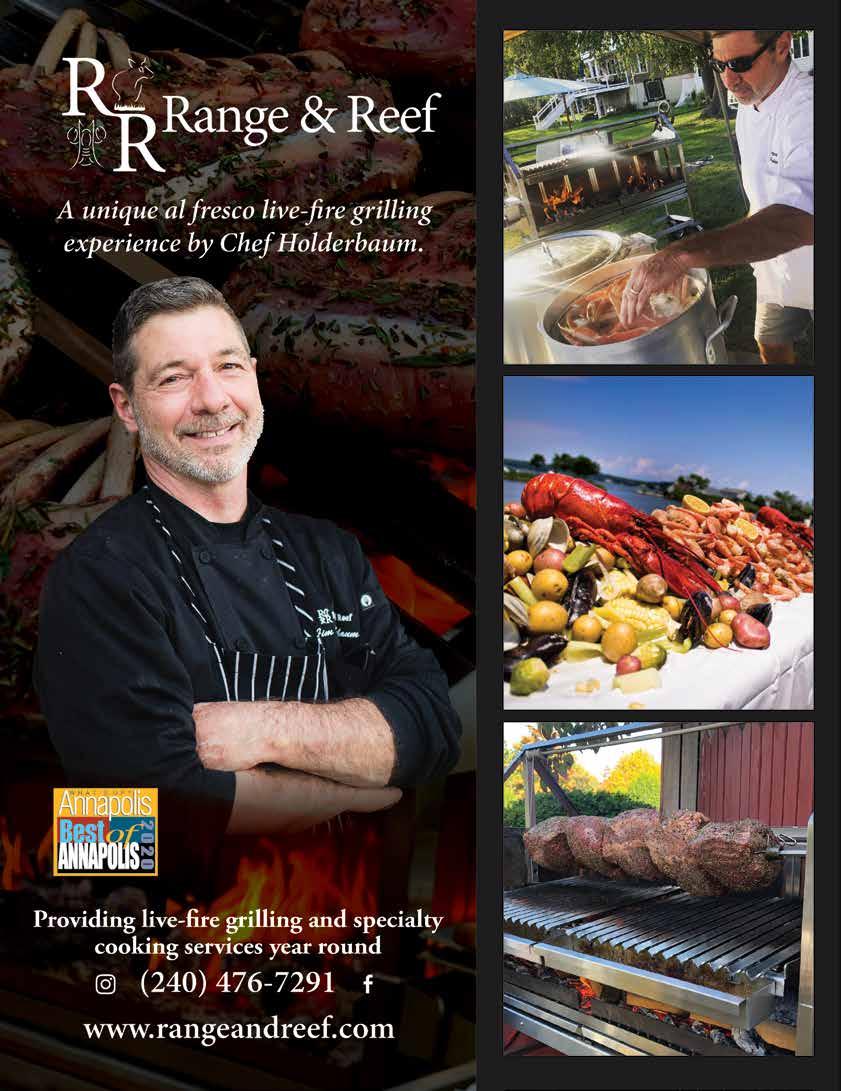
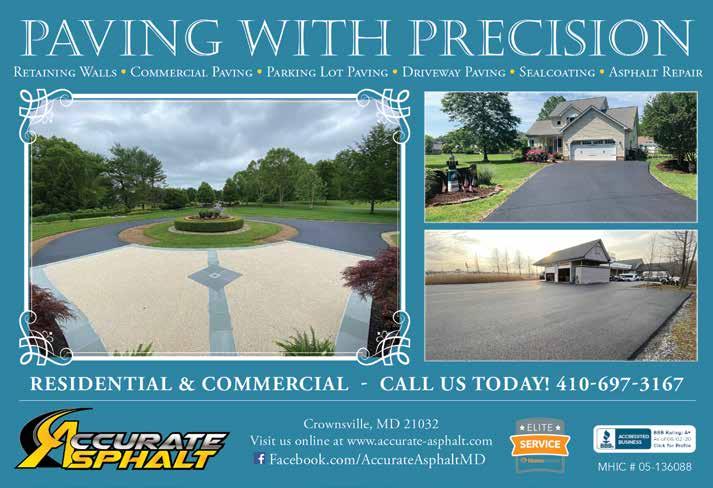

Home Design +
96 HOME RESOURCE GUIDE | 105 REFLECTIVE & HOPEFUL | 110 SPRING CLEAN 114 PORCHES, DECKS & PATIOS | 116 REAL ESTATE













